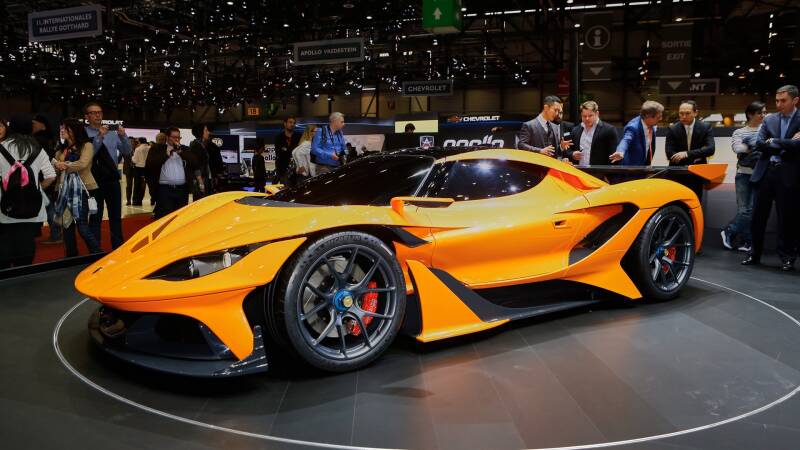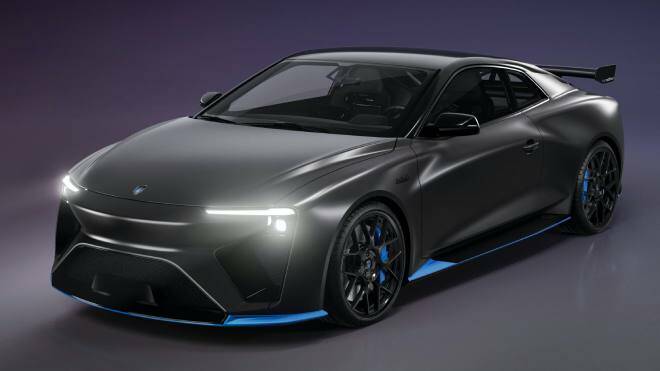




Apollo Automobil (previously known as Gumpert Sportwagenmanufaktur) is a German sports car manufacturer headquartered in Denkendorf. Roland Gumpert, who founded Gumpert Sportwagenmanufaktur in 2004, once held the position of director of Audi Sport. Under his management, Audi won a total of 25 World Rally Championship rallies and four World Rally Championship titles.
In 2001, Roland Gumpert proposed a new generation of sports car, one that would be race-ready yet also street-legal. After Gumpert returned to Germany from China at the end of 2001, his former colleague at Audi and founder of Motoren Technik Mayer, Roland Meyer, asked him to assist in building a prototype sports car. Audi approved Gumpert's involvement in this project on the condition that the new sports car would be a series product and not a prototype.
The company was founded in 2004 under the name "GMG Sportwagenmanufaktur Altenburg GmbH". The technical guidelines were defined and the first designs of the car were drawn by Marco Vanetta. Upon Vanetta's completion of this process, the first 1:4 scale model of Gumpert's car was produced in 2002.
apollo


2005-



Gumpert continued with the development of the car now called the Apollo, along with the Technical University of Munich and the Ingolstadt University of Applied Sciences. They assisted him with the construction work, computer simulations, and wind tunnel tests. This research and development helped form the blueprint for the first full-scale model. Finally two prototype cars were constructed. The production of the Apollo started in October 2005.Many variants of the Apollo were introduced throughout its production cycle.
The Apollo uses a 4,163 cc bi-turbo intercooled version of the Audi V8 engine. Top speed: 360.4 km/h , 0-100 km/h : 3.1 seconds and 0-200 km/h : 9.1 seconds (650ps version )
There are 3 engine types available:
- Base version - approximately 650 PS
- Sport version - approximately 700 PS
- Race version - approximately 800 PS
The Apollo can weigh between 1,100 kg and 1,200 kg (depending on options), and is fully street-legal. It is a mid-engine, rear wheel drive two-seater constructed on a tubular chromoly frame, with fiberglass or optional carbon fibre body panels. Gumpert claims the design of the Apollo is optimised so that the car could drive upside-down in a tunnel if driven at sufficiently high speeds [over 306 km/h], but this has not been tested.
motorsports

luxon racing
During April 2005, the Apollo made its racing debut in the Divinol Cup. This Apollo was driven by the Belgian race driver Ruben Maes. Maes finished third on the Hockenheimring race track. Three years later Gumpert announced that they would enter a hybrid electric version of the Apollo in the 2008 24 Hours Nürburgring, driven by 2004 winner Dirk Müller and former Formula One racer Heinz-Harald Frentzen. Three months passed between the first discussions and the finished hybrid Apollo. The Apollo was driven in the 24 Hours Nürburgring in May 2008. The hybrid Apollo can deliver up to 639 PS, powered with a 3.3 litre V8 bi-turbo engine coupled with a 136 PS electric motor. The car has the ability to recharge the battery under braking.
tornante

2012



The Gumpert Tornante by Touring is a static style model projected and engineered to match a new central engine chassis with V8-powered driveline. The Tornante was scheduled as an addition to the GUMPERT model range as of 2012. Touring was commissioned a design adding elegance, space and comfort to a package rooted in motorsports and competition engineering. The result aims at opening a new class with attributes of superior efficiency, performance and pleasure: the Fast Tourers.
The Tornante has the genes of the Gumpert Apollo and inherits its impressive V8 Biturbo engine. The 4.2 liter unit delivers 700 HP in the basis version.
A typical feature is the gull-wing opening of both the doors and the wide rear hood.

In January 2016, the company was purchased by Hong Kong consortium Ideal Team Venture which is also owner of the De Tomaso marque. The company was renamed Apollo Automobil GmbH after the acquisition by its new owner.
arrow


2016



The Apollo Arrow is a mid-engine, 2-seater concept car developed by Apollo Automobil. It was introduced in 2016 at the Geneva Motor Show.
The Arrow was co-developed by Scuderia Cameron Glickenhaus (SCG) and Apollo Automobil, while Roland Gumpert was CEO of Apollo. It was planned that an Italian company MAT, the company that builds the SCG 003C would be appointed to produce the production version of the car. SCG stated that a production version of the Arrow would consist of a track only version with a V12 engine, code named 'Titan', in 2017, followed by a road going version called the Apollo S with a twin-turbocharged V8 engine, and that both models will “utilise the chassis technology developed for the SCG003C”, but as of 2018 neither model has reached production stages primarily due to the management of Apollo Automobil focusing on the development of a separate model.
The Arrow concept is powered by a 4.0 L, twin turbocharged Audi V8 that is rated at 999 PS and 999 N⋅m of torque. Power is sent to the rear wheels through a 7-speed sequential manual transmission. The Arrow is built on a tubular chromoly space frame combined with a carbon fibre tub, the design of which is a modified version of the one used in the original Gumpert Apollo, and subsequently the 2016 ApolloN concept. Apollo claims the Arrow weighs under 1,315 kg. Apollo claims the Arrow can accelerate from 0-100 km/h in 2.9 seconds and can attain a top speed of 360 km/h.
apollo N


2016-


The Apollo N was unveiled at the 2016 Geneva Motor Show as an updated version of the Gumpert Apollo. The 'N' in the name symbolizes the Nürburgring, the race track Apollo plans to use to hone all of its future cars.
The specifications of the N match those of Gumpert's most recent Apollo, the Apollo S. Power comes from an Audi twin-turbocharged 4.2-liter V8, rated at 690 horsepower and 649 pound-feet of torque. Drive is to the rear wheels only, via a 7-speed sequential transmission.
The Apollo N has well-rounded performance with a very high top speed of 388 km/h; this is faster than all Class B and A cars apart from the McLaren F1 LM, McLaren 570S Spider, and Aston Martin Valhalla. The Apollo N excels on tracks with long straight sections, like Cairo and The Himalayas, where it can reach its top speed and pull away from/catch up to other cars. However, the Apollo N is not as dominant on technical tracks as the superior handling, acceleration, and nitrous efficiency of the Chevrolet Corvette Grand Sport, Porsche 911 GT3 RS, and the Lamborghini Huracán EVO Spyder allows them to post faster lap times. Apollo claims that “no other street legal super sports car generates more downforce than the Apollo N,” and I believe it. The whole design looks like it was styled by an algorithm, and anyone who likes it would probably get all hot and bothered by a very detailed wind tunnel graph readout.
Inside, things are pretty basic for the two-seater. The layout and look is basically unchanged over the outgoing Gumpert, excluding a new instrument cluster and adjustable digital display.
intensa emozione

2019-



The Apollo Intensa Emozione, sometimes referred as the IE, is a mid-engine sports car manufactured by German automobile manufacturer Apollo Automobil GmbH, designed by their chief designer Joe Wang. The name itself means 'intense emotion' in Italian.
This is the first vehicle made by Apollo since the Gumpert Apollo that went into production 14 years before.
Apollo came out with a teaser video for the Intensa Emozione at October 17, 2017. The car was fully revealed on October 24, 2017. The Intensa Emozione is built in collaboration with HWA AG. The Intensa Emozione will be sold for €2,300,000 in Europe. Only ten will be produced, all of which have been reportedly sold.
The exterior design is based on airflow and nature, insects and marine animals in particular. The interior is based entirely on the nature theme, with a cocoon-style carbon fiber tub cockpit, in the style of a leather-wrapped prototype race car. Apart from the natural thought, the car was also intended to have a design that would stand out from all other sports cars.
The Intensa Emozione uses a Ferrari derived 6.3-litre naturally-aspirated V12 engine developed by Autotecnica Motori and HWA AG. It is rated approximately 791 PS at 8,500 rpm and around 760 N⋅m of torque at 6,000 rpm. The engine reportedly has a redline of 9,000 rpm. All of the power is sent to the rear wheels through a 6-speed Hewland sequential manual transmission. The weight stands at 1,250 kg. The car is capable of accelerating from 0–100 km/h in 2.7 seconds, with a projected top speed of 335 km/h.

Roland Gumpert is a former president of Audi Sport. In 2001, he had founded the automobile manufacturer Gumpert, to produce a supercar named Gumpert Apollo. In 2014, the company went bankrupt, and was taken over by Hong Kong businessman Norman Choi and consortium Consolidated Ideal TeamVenture, the owner of De Tomaso, which renames it Apollo Automobil Gmbh and produces the Apollo Intensa Emozione.
In 2017, Roland Gumpert joined forces with Aiways, a Chinese company based in Shanghai and specialist in alternative energies, and founded his new company called “RG”, initials of Roland Gumpert, based in Ingolstadt in Germany.
nathalie

2021-present



The Gumpert Nathalie or RG Nathalie is a hydrogen-electric hybrid sports car running on methanol to generate hydrogen that is scheduled to enter production in 2021. It is the first car produced by the new car manufacturer RG founded by Roland Gumpert, following the bankruptcy of his company Gumpert which produced the Apollo. It is produced in 500 copies.
The Nathalie is a two-seater coupe, its line is close to the Nissan GT-R. It is designed on a very light carbon shell which gives it high performance with a maximum speed of 300 km/h and a 0 to 100 km/h in 2.5 seconds.
The Nathalie receives four electric motors of 200 hp, each placed in the wheels. They develop a combined power of 540 hp transmitted on all four wheels.
The Nathalie is equipped with a 20 hp fuel cell which operates on methanol and supplies a 70 kWh (250 MJ) battery. The complex system developed by RG consists of a methanol reformer which, by a catalyzed chemical reaction, divides methanol into carbon dioxide and hydrogen, the latter feeding the fuel cell which produces electricity.








Create Your Own Website With JouwWeb